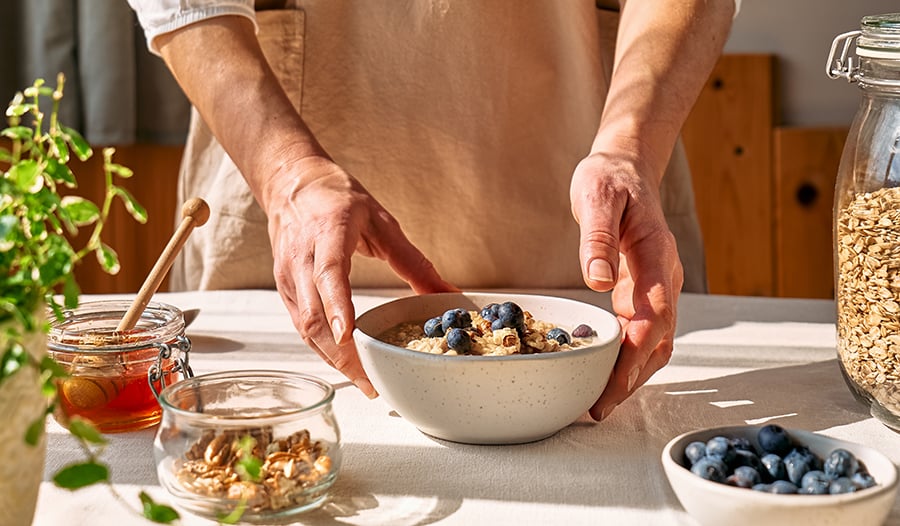La dietista consiglia: 20 alimenti ricchi di fibre da aggiungere alla dieta

I concetti di base
- Le fibre sono fondamentali per la salute dell'apparato digerente, per il controllo della glicemia e per il mantenimento di un peso sano.
- Le donne dovrebbero assumere circa 25 grammi di fibre al giorno, mentre gli uomini circa 38 grammi.
- Tra le migliori fonti di fibre troviamo i legumi (fagioli e lenticchie), la frutta (bacche e pere), la verdura (broccoli e carciofi) e i cereali integrali (avena e quinoa).
- Un modo semplice per aumentarne l'assunzione è aggiungere un cucchiaio di semi di chia o di lino ai nostri frullati e yogurt.
Che cosa sono le fibre?
Le fibre alimentari, comunemente chiamate solo "fibre" quando si parla di alimentazione, sono una tipologia di carboidrati che il nostro organismo non è in grado di digerire. Le fibre si trovano soprattutto in frutta, verdura, frutta a guscio, semi, legumi e cereali integrali. Un consumo adeguato di fibre alimentari può aiutare a favorire la regolarità e l'efficacia dei movimenti intestinali e migliorare la salute del tratto digerente, ma non solo. Le fibre sono infatti importanti anche per la salute del cuore, per la gestione del peso e per ridurre il rischio di diabete.
Tipi di fibre
Grassi, proteine e carboidrati sono i macronutrienti che l'organismo scompone e assorbe per ricavarne energia. Le fibre alimentari sono invece uniche nel loro genere, in quanto l'organismo non è in grado di digerirle e assorbirle. Esistono due tipi di fibre, quelle solubili e quelle insolubili. Alcuni alimenti contengono sia fibre solubili che insolubili.
Fibre solubili
Le fibre solubili possono sciogliersi in acqua e creano una massa dalla consistenza gelatinosa che migliora la forma, le dimensioni e la consistenza delle feci, aiutando a facilitare il transito intestinale. Le fibre solubili possono anche migliorare la salute dell'intestino favorendo la crescita della flora batterica residente.1
Questi alimenti sono ottime fonti di fibre solubili:
- Avena
- Mele
- Carote
- Agrumi
- Psillio
- Fagioli
- Albicocche
- Semi di lino macinati
- Semi di girasole
- Patate dolci
- Avocado
Fibre insolubili
Le fibre insolubili non si sciolgono in acqua. Questo tipo di fibre può accelerare il tempo di transito intestinale, facilitando il movimento delle feci attraverso il tratto digestivo.2
I seguenti alimenti sono ricchi di fibre insolubili:
- Mele, con la buccia
- Pere, con buccia
- Fagioli e lenticchie
- Frutti di bosco e bacche
- Farina di grano integrale
- Crusca di grano
- Cavolfiore
- Patate
- Spinaci
- Gombo
- Frutta disidratata: uvetta, prugne, datteri e albicocche
- Mandorle
- Noci
- Popcorn
Quali sono i benefici delle fibre per la salute?
Le fibre hanno molti benefici per la salute! Ecco alcuni dei loro effetti positivi:3
- Aiutano a prevenire e contrastare la stitichezza;
- Aiutano a rallentare l'assorbimento dello zucchero, e dei carbodrati in generale, contribuendo a mantenere la glicemia entro valori salutari;
- Possono contribuire a ridurre il rischio di cancro al colon-retto;
- Possono aiutare nella gestione del peso, aumentando il senso di sazietà e facendoci sentire appagati più a lungo;
- Possono ridurre il rischio di diverticolite ;
- Favoriscono la diversità microbica intestinale, contribuendo alla salute generale dell'intestino.
Quante fibre dovrei mangiare al giorno?
L'American Heart Association raccomanda di assumere dai 25 ai 35 grammi di fibre al giorno (provenienti da fonti alimentari e non dagli integratori). Tuttavia, la dieta dell'americano medio è spesso ricca di cibi lavorati e povera di fibre. Questa raccomandazione è quindi raramente rispettata e la maggior parte delle persone consuma in media solo 15 grammi di fibre al giorno in America.
I migliori 20 alimenti ad alto contenuto di fibre
Assumere più fibre è molto più facile di quello che si potrebbe pensare ed è anche un'esperienza ricca di gusto! A questo punto, però, ti starai chiedendo: quali sono gli alimenti ricchi di fibre? Fortunatamente, sono molti gli alimenti naturalmente ricchi di fibre. Aggiungi questi alimenti ad alto contenuto di fibre alla tua lista della spesa per aumentare già da oggi il tuo apporto di fibre!
- Avena: l'avena contiene sia fibre insolubili che solubili. Una mezza tazza di avena fornisce circa 4 grammi di fibre alimentari. L'avena contiene anche un tipo di fibre solubili note come beta-glucani, che possono aiutare a ridurre i livelli di colesterolo "cattivo" LDL e a migliorare il controllo della glicemia. L'avena può essere usata in molti modi, come porridge caldi e freddi (ad esempio l'oatmeal o l'overnight oats), aggiunta a prodotti da forno o utilizzata sotto forma di farina d'avena per deliziose preparazioni.
- Semi di girasole: i semi di girasole sono una fonte di fibre solubili. Un quarto di tazza di semi di girasole contiene circa 3 grammi di fibre alimentari e 6 grammi di proteine! Puoi gustare i semi di girasole da soli, nei trail mix (assieme ad altri semi e/o frutta secca), come aggiunta alle insalatone o per arricchire un bello yogurt.
- Semi di lino macinati: un cucchiaio di semi di lino macinati contiene 3,5 grammi di fibre e 2 grammi di proteine! Puoi conprare direttamente i semi di lino macinati oppure acquistali interi e macinali a casa. I semi di lino macinati sono più facili da digerire e da assorbire rispetto a quelli interi, consentendo al tuo corpo di ottenere tutti i benefici nutrizionali di questi semi. I semi di lino macinati sono ottimi da aggiungere ai fiocchi d'avena, ai frullati o nelle ricette al forno.
- Carote: 150 grammi di carote contengono circa 4,6 grammi di fibre. Le carote forniscono anche beta-carotene, che viene convertito in vitamina A per favorire la salute degli occhi!
- Albicocche: un'albicocca offre su per giù 2,1 grammi di fibre. Le albicocche secche sono un altro modo delizioso per aumentare l'apporto di fibre. Usa le albicocche secche nei biscotti energetici fatti in casa, nella granola o sulla farina d'avena!
- Broccoli: i broccoli sono verdure crucifere con molti benefici per la salute! 100 grammi di broccoli crudi contengono circa 2,4 grammi di fibre. Puoi mangiare i broccoli come contorno (crudi, bolliti o saltati), nelle zuppe o come condimento per la pasta.
- Lenticchie: una mezza tazza di lenticchie cotte contiene attorno agli 8 grammi di fibre e circa 9 grammi di proteine vegetali! Le lenticchie sono anche un'ottima fonte di ferro. Si prestano molto bene alla preparazione di zuppe, ma sono anche una deliziosa alternativa alla carne che si può gustare con la pasta, nei tacos o come polpette (anche per fare "hamburger" vegetariani o vegani)! In generale, sono uno dei migliori alimenti ad alto contenuto di fibre che abbiamo a disposizione.
- Avocado: gli avocado contengono sia fibre solubili che insolubili. Una porzione di avocado, pari a circa un terzo dell'intero frutto, contiene 4,5 grammi di fibre. Un avocado intero fornisce invece circa 13,5 grammi di fibre! Gli avocado possono essere utilizzati per preparare un gustoso guacamole, anche come salsa per un panino o una piadina, oppure tagliati a fette e aggiunti a un'insalata o a un frullato. Possono persino essere usati per dolci fatti in casa, come il budino di avocado al cioccolato!
- Patate dolci: una patata dolce di medie dimensioni può contenere 4 grammi di fibre, la maggior parte delle quali sono fibre solubili! Le patate dolci contengono anche potassio, vitamine del gruppo B e beta-carotene, che si converte in vitamina A all'interno dell'organismo. Le patate dolci sono deliziose al forno, come purè, fritte, saltate in padella o anche semplicemente in insalata!
- Fagioli neri: una mezza tazza di fagioli neri contiene 7,5 grammi di fibre e 7,6 grammi di proteine vegetali! I fagioli neri sono anche una fonte di ferro. Sono ottimi nelle zuppe, nei tacos, negli hamburger, nei burritos, nelle insalate o serviti assieme a del riso!
- Mandorle: 30 grammi di mandorle (circa 20-24 mandorle) contengono 3 grammi di fibre e 6 grammi di proteine! Le mandorle sono anche ricche di vitamina E, un potente antiossidante. Possono essere gustate da sole, nei trail mix con altra frutta secca, assieme a yogurt o fiocchi d'avena, nelle insalate o in varie ricette al forno.
- Noci: 30 grammi di noci (circa 7 noci) contengono 1,9 grammi di fibre e 4,3 grammi di proteine! Le noci sono anche ricche di acidi grassi Omega-3, che possono favorire la salute del cervello e del cuore.4,5 Le noci possono essere consumate da sole, aggiunte ai fiocchi d'avena o allo yogurt, nei trail mix, nelle insalate, nei frullati o nelle ricette al forno.
- Quinoa: una tazza di quinoa cotta contiene 5 grammi di fibre e 8 grammi di proteine vegetali! La quinoa è un cereale naturalmente privo di glutine. Sebbene la quinoa sia tecnicamente un seme, viene spesso indicata come un cereale, nonché cucinata come tale. Può essere gustata come contorno, aggiunta a insalate o preparata come porridge caldo per la colazione.
- Riso integrale: 100 grammi di riso integrale crudo contengono circa 3 grammi di fibre. Il riso è anche una fonte di calcio, ferro, manganese e magnesio. Il riso integrale può essere gustato come primo, come contorno, nelle zuppe e perfino a colazione (usanza comune in diversi paesi asiatici).
- Semi di chia: solo 2 cucchiai di semi di chia contengono 9,8 grammi di fibre e 4,7 grammi di proteine! I semi di chia sono incredibilmente nutrienti e sono una fonte di calcio, ferro, magnesio, fosforo, zinco, vitamina B1 e vitamina B3. I semi di chia possono essere utilizzati nei pudding alla chia, nei fiocchi d'avena, nell'overnight oats (avena fredda ammollata), nei frullati, nelle marmellate, nei dessert e in diverse ricette al forno.
- Semi di zucca: un quarto di tazza di semi di zucca contiene 1,7 grammi di fibre e 8 grammi di proteine vegetali! I semi di zucca sono anche ricchi di antiossidanti, ferro, zinco e magnesio. Si possono mangiare come snack, nei trail mix, nelle insalatone o nelle ricette al forno!
- Guava: un piccolo frutto di guava contiene 3 grammi di fibre! I frutti di guava sono anche ricchi di antiossidanti e vitamina C. La guava è deliziosa come frutto fresco, come aggiunta a uno yogurt, nel porridge o nei cereali, nei frullati, come aggiunta ai dessert e altro ancora!
- Fragole: 150 grammi di fragole offrono 2,9 grammi di fibre. Le fragole sono un alimento a basso indice glicemico e ricco di vitamina C . Godetevi le fragole così come sono, oppure in aggiunta a frullati, ricette al forno, marmellate, macedonie e molto altro!
- Cavolfiore: un etto di cavolfiore crudo contiene circa 2,1 grammi di fibre. Il cavolfiore è anche un'ottima fonte di vitamina C, folato (vitamina B9) e vitamina K. Si può mangiare arrosto o bollito come contorno, in aggiunta alle insalate o al purè di patate, sulla pizza o tagliato a dadini e inserito in panini, tacos, burritos, hamburger e altro ancora!
- Prugne secche: le prugne secche sono un ottimo modo per aumentare l'apporto di fibre! Una porzione di cinque prugne secche fornisce 3 grammi di fibre. Le prugne secche sono anche una buona fonte di vitamina A, vitamina C, vitamina K, ferro, magnesio, rame e vitamina B6! Le prugne secche possono essere gustate così come sono, nei trail mix, o in aggiunta a ricette al forno, muesli, frullati e cereali da colazione.
Ecco 5 modi semplici per aggiungere più fibre alla tua giornata
- Prepara un frullato con frutta e verdura (usa banane, spinaci, frutti di bosco, semi di lino macinati e le tue proteine in polvere preferite);
- Prepara a un panino ricco di spinaci;
- Arricchisci il tuo sugo della pasta con verdure a cubetti. Puoi usare zucchine, pomodori e persino i funghi;
- Aggiungi le lenticchie o i fagioli neri alle tue ricette a base di carne trita come ragù, hamburgher, polpette e molto altro;
- Come spuntino ricco di fibre, mangia un frutto assieme a una manciata di frutta secca o semi.
Uno dei modi più semplici per aumentare l'apporto giornaliero di fibre è quello di aggiungere ai tuoi piatti quanti più alimenti di origine vegetale (frutta, verdura, noci e frutta a guscio, semi, fagioli e altri legumi, cereali integrali, erbe e spezie).
Bibliografia:
- Guan ZW, Yu EZ, Feng Q. Fibra alimentare solubile, uno dei nutrienti più importanti per il microbiota intestinale. Molecole. 2021 Nov 11;26(22):6802.
- {van der Schoot A, Drysdale C, Whelan K, Dimidi E. Effetto dell'integrazione di fibre sulla costipazione cronica negli adulti: An Updated Systematic Review and Meta-Analysis of Randomized Controlled Trials. Am J Clin Nutr. 2022 Oct 6;116(4):953-969.
- Barber TM, Kabisch S, Pfeiffer AFH, Weickert MO. The Health Benefits of Dietary Fibre. Nutrients. 2020 Oct 21;12(10):3209.
- Dighriri IM, Alsubaie AM, Hakami FM, Hamithi DM, Alshekh MM, Khobrani FA, Dalak FE, Hakami AA, Alsueaadi EH, Alsaawi LS, Alshammari SF, Alqahtani AS, Alawi IA, Aljuaid AA, Tawhari MQ. Effetti degli acidi grassi polinsaturi Omega-3 sulle funzioni cerebrali: Una revisione sistematica. Cureus. 2022 Oct 9;14(10):e30091.
- Elagizi A, Lavie CJ, O'Keefe E, Marshall K, O'Keefe JH, Milani RV. Aggiornamento sugli acidi grassi polinsaturi Omega-3 e la salute cardiovascolare. Nutrienti. 2021 Jan 12;13(1):204.
ESONERO DI RESPONSABILITÀ:Questo Centro Benessere non intende fornire diagnosi...














































































 Indice
Indice
















